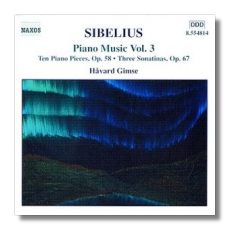
The Internet's Premier Classical Music Source
Related Links
- Sibelius Reviews
- Latest Reviews
- More Reviews
-
By Composer
-
Collections
DVD & Blu-ray
Books
Concert Reviews
Articles/Interviews
Software
Audio
Search Amazon
Recommended Links
Site News
 CD Review
CD Review
Jean Sibelius

Piano Music - Volume 3
- Ten Piano Pieces, Op. 58
- Three Sonatinas, Op. 67
- Two Rondinos, Op. 68
Havard Gimse, piano
Naxos 8.554814
I reviewed the first disc in this series for another publication a year or so ago and found its music charming but, like most of Sibelius' keyboard output, not divulging much innovation or individuality. The violin was the composer's instrument, but he wrote a surprisingly substantial body of piano music, twenty-six works or collections of works, in all. Most of them were spaced throughout his career, a fact that suggests he had an abiding interest in the piano, despite receiving no accolades worth mention for the keyboard music he composed and little encouragement from pianists interested in playing it.
The Ten Pieces in this collection are not to be confused with the Ten Pieces, Op. 24, which date to the period 1894-1903. The Op. 58 set was written in 1909 and is on the whole a more interesting collection. Yet, the quality of the individual works can be variable and Sibelius' own voice is often buried in an uncharacteristic exoticism. #4, for example, The Shepherd, has a decidedly Spanish flavor. It's a charming piece nevertheless, but whatever prompted Sibelius to title it so is a mystery. The quirky, graceful #7, Tempo di Minuetto, is another example of a work not characteristic of the composer's style, at least of the style of his orchestral music. The first piece in the set, Rêverie, recalls Debussy, but early-Debussy, from around the period of the two Arabesques. On the whole the Ten Pieces are attractive and would be enjoyed by most listeners who find piano music from latter half of the 19th century to their liking.
The Three Sonatinas, from 1912, are more Sibelian in sound. Light, tuneful and quite pleasant, they call to mind the composer's less-serious side, like that heard in the Third Symphony, though lacking the heroism that appears in the finale there. Each consists of three short movements, and each lasts in the range of five-and-a-half to seven minutes. That terseness of expression says a lot: Sibelius makes no serious attempt at development and keeps everything on the surface. That's not necessarily a drawback, but some will find it so.
The Two Rondinos are also attractive, the first actually showing a dark, serious side. In the end, this recital contains consistently engaging works, though in a single dose they might be hard to take. Havard Gimse, apparently a Norwegian (the notes don't tell us where he was born, only that he graduated from the Norwegian State Academy of Music), is a talented pianist whose sense for nuance and lightness of touch seem perfectly attuned to this charming music. Naxos provides its usual excellent sound and fine notes.
Copyright © 2002, Robert Cummings


















